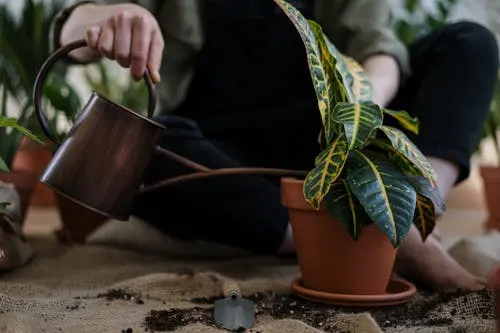Croton plants, known scientifically as Codiaeum variegatum, are prized for their stunning, multicolored leaves that bring a burst of tropical flair to any space. With vibrant hues of red, yellow, orange, and green, these plants are a favorite among indoor and outdoor gardeners. However, their beauty comes with specific care requirements. This guide covers everything you need to know about croton plant care
Understanding the Croton Plant Care
Crotons are native to tropical regions like Southeast Asia and Oceania, thriving in warm, humid environments. Their leaves vary in shape and color, depending on the variety, making them a striking addition to homes or gardens. While they’re relatively low-maintenance, crotons are sensitive to changes in their environment, so proper care is essential for their health and vibrancy.
Light Requirements
Crotons love bright, indirect light to maintain their vivid colors. Place them near a south- or west-facing window where they can receive at least 4–6 hours of filtered sunlight daily. Too little light can cause their colors to fade, while direct sunlight may scorch the leaves. If you notice leggy growth or dull foliage, consider moving your croton to a brighter spot or supplementing with a grow light.
Watering Needs
Water your croton when the top inch of soil feels dry to the touch, typically every 1–2 weeks. Ensure the soil is well-draining to prevent root rot, as crotons are sensitive to overwatering. Use a pot with drainage holes and avoid letting the plant sit in standing water. During winter, reduce watering as the plant’s growth slows. If the leaves start to droop, it’s a sign your croton needs water.
Soil and Potting
Crotons thrive in well-draining, fertile soil. A standard potting mix blended with perlite or sand works well to ensure proper drainage. Repot your croton every 1–2 years or when it becomes root-bound, choosing a pot slightly larger than the current one. Spring is the best time for repotting, as the plant is entering its active growth phase.
Humidity and Temperature
As tropical plants, crotons prefer high humidity levels (50–70%). If your home is dry, especially in winter, increase humidity by misting the leaves, placing a humidifier nearby, or setting the pot on a tray of pebbles with water. Maintain temperatures between 60–85°F (15–29°C). Avoid cold drafts or sudden temperature changes, which can cause leaf drop.
Fertilizing Your Croton
Feed your croton with a balanced, water-soluble fertilizer (e.g., 10-10-10) every 4–6 weeks during the growing season (spring and summer). Dilute the fertilizer to half strength to avoid overfeeding, which can lead to salt buildup in the soil. In fall and winter, reduce or stop fertilizing as the plant’s growth slows.
Pruning and Maintenance
Regular pruning helps maintain your croton’s shape and encourages bushier growth. Trim back leggy stems in spring using clean, sharp scissors. Remove any yellowing or damaged leaves to keep the plant healthy. Wipe the leaves with a damp cloth to remove dust and enhance their shine, but avoid leaf-shine products, which can clog pores.

Common Pests and Problems
Crotons are susceptible to pests like spider mites, mealybugs, and scale. Inspect your plant regularly and treat infestations promptly with insecticidal soap or neem oil. Common issues include:
- Leaf Drop: Often caused by cold temperatures, overwatering, or low humidity.
- Fading Colors: Indicates insufficient light.
- Wilting: Suggests underwatering or poor drainage.
Address these problems by adjusting care conditions and monitoring your plant closely.
Propagating Crotons
You can propagate crotons through stem cuttings. Take a 4–6-inch cutting with several leaves, remove the lower leaves, and place it in water or moist soil. Keep the cutting in a warm, humid spot with bright, indirect light. Roots should develop in 4–6 weeks, after which you can transfer the cutting to a pot.
Toxicity Warning
Crotons are toxic to pets and humans if ingested, and their sap can irritate skin. Keep them out of reach of children and animals, and wear gloves when handling cuttings or pruning to avoid skin irritation.
Final Tips for Success
- Rotate your croton periodically to ensure even light exposure.
- Be patient with leaf drop; it’s normal for crotons to shed a few leaves when moved to a new environment.
- Monitor for signs of stress and adjust care promptly to keep your plant vibrant.
With the right care, your croton will reward you with stunning, colorful foliage year-round. Whether you’re a seasoned plant parent or a beginner, these tips will help you keep your croton healthy and thriving.



